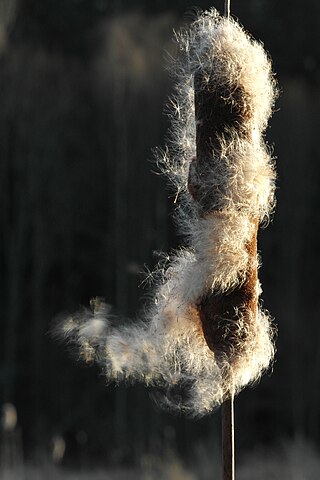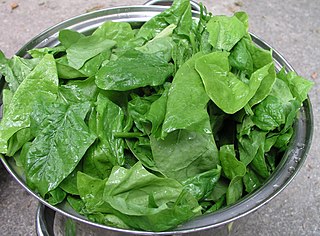Related Research Articles

Typha is a genus of about 30 species of monocotyledonous flowering plants in the family Typhaceae. These plants have a variety of common names, in British English as bulrush or reedmace, in American English as hot dog plant, reed, cattail, or punks, in Australia as cumbungi or bulrush, in Canada as bulrush or cattail, and in New Zealand as reed, cattail, bulrush or raupo. Other taxa of plants may be known as bulrush, including some sedges in Scirpus and related genera.

Common chicory is a somewhat woody, perennial herbaceous plant of the family Asteraceae, usually with bright blue flowers, rarely white or pink. Native to Europe, it has been introduced to the Americas and Australia.

Matricaria discoidea, commonly known as pineappleweed, wild chamomile, disc mayweed, and rayless mayweed, is an annual plant native to North America and introduced to Eurasia where it grows as a common herb of fields, gardens, and roadsides. It is in the daisy family Asteraceae. The flowers exude a chamomile/pineapple aroma when crushed. They are edible and have been used in salads and to make herbal tea.

Watercress or yellowcress is a species of aquatic flowering plant in the cabbage family, Brassicaceae.

Rumex crispus, the curly dock, curled dock or yellow dock, is a perennial flowering plant in the family Polygonaceae, native to Europe and Western Asia.

Hypochaeris radicata – also known as catsear, flatweed, cat's-ear, hairy cat's ear, or false dandelion – is a perennial, low-lying edible herb often found in lawns. The plant is native to Europe, but has also been introduced to the Americas, Japan, Australia, and New Zealand, where it can be an invasive weed. It is listed as a noxious weed in the northwestern U.S. state of Washington.

Leaf vegetables, also called leafy greens, pot herbs, vegetable greens, or simply greens, are plant leaves eaten as a vegetable, sometimes accompanied by tender petioles and shoots. Leaf vegetables eaten raw in a salad can be called salad greens.

Capsella bursa-pastoris, known as shepherd's purse because of its triangular flat fruits, which are purse-like, is a small annual and ruderal flowering plant in the mustard family (Brassicaceae). It is native to eastern Europe and Asia minor, but is naturalized and considered a common weed in many parts of the world, especially in colder climates, including the British Isles, where it is regarded as an archaeophyte, North America and China, but also in the Mediterranean and North Africa. C. bursa-pastoris is the second-most prolific wild plant in the world, and is common on cultivated ground and waysides and meadows.

Rhus typhina, the staghorn sumac, is a species of flowering plant in the family Anacardiaceae, native to eastern North America. It is primarily found in southeastern Canada, the northeastern and midwestern United States, and the Appalachian Mountains, but it is widely cultivated as an ornamental throughout the temperate world. It is an invasive species in some parts of the world.

Lactuca serriola, also called prickly lettuce, milk thistle, compass plant, and scarole, is an annual or biennial plant in the tribe Cichorieae within the family Asteraceae. It has a slightly fetid odor and is commonly considered a weed of orchards, roadsides and field crops. It is the closest wild relative of cultivated lettuce.

Tropaeolum majus, the garden nasturtium, nasturtium, Indian cress or monk's cress, is a species of flowering plant in the family Tropaeolaceae, originating in the Andes from Bolivia north to Colombia. An easily-grown annual or short-lived perennial with disc-shaped leaves and brilliant yellow, orange or red flowers, it is of cultivated, probably hybrid origin. It is not closely related to the genus Nasturtium.

Sonchus oleraceus is a species of flowering plant in the tribe Cichorieae of the family Asteraceae, native to Europe and Western Asia. It has many common names including common sowthistle, sow thistle, smooth sow thistle, annual sow thistle, hare's colwort, hare's thistle, milky tassel, milk thistle, and soft thistle.

Galeopsis bifida is an annual plant native to Europe and Asia but now found in Canada and the northeastern, midwestern parts of the United States. It has many common names such as bifid hemp-nettle, split-lip hemp-nettle, common hemp-nettle, and large-flowered hemp-nettle. The genus name means weasel-like, referring to the corolla of the flower. It is often confused with other species of Lamiaceae such as Mentha arvensis, Dracocephalum parviflorum and Stachys pilosa.
Steve "Wildman" Brill is an American forager, naturalist, environmental educator and author. He gained notoriety in 1986, when he was arrested in New York City's Central Park for eating a dandelion.

Rubus argutus is a North American species of prickly bramble in the rose family. It is a perennial plant native to the eastern and south-central United States. Common names are sawtooth blackberry or tall blackberry after its high growth.

Oxypolis rigidior, known as cowbane, common water dropwort, stiff cowbane, pig-potato, and Cherokee swamp potato, is a species of flowering plant in the carrot family native to eastern North America. It is a perennial wildflower found in wet habitats. Oxypolis rigidior has been reported as being poisonous to some mammals, but it is also considered edible and safe by some authors.

Persicaria hydropiperoides, commonly called swamp smartweed, mild waterpepper, false waterpepper, or sometimes simply waterpepper, is a species of flowering plant in the buckwheat family. It has a widespread distribution across much of North America and South America. Its preferred habitat is in moist, saturated to inundated soils growing in full sun to partial shade; such as swamp forests, marshes, streams, shorelines, and ditches. It is sometimes semi-aquatic.

Camassia leichtlinii, the great camas or large camas, is a species of flowering plant in the family Asparagaceae. This herbaceous perennial is native to western North America in British Columbia, Canada and California, Nevada, Oregon and Washington, in the United States.
Naturalist Lee Allen Peterson is the author of A Field Guide to Edible Wild Plants of Eastern and Central North America, a leading reference in survivalist foraging and cooking with wild plants. The book is illustrated with photographs by Peterson, as well as line drawings by both him and his father, Roger Tory Peterson.
References
- ↑ "Sam Thayer". Wisconsin Public Radio. 27 August 2013.
- ↑ Hardee, Howard (20 September 2018). "More than Weeds". Isthmus.
- ↑ Shute, Nancy. "Foraging the Weeds for Wild, Healthy Greens". National Public Radio.
- ↑ Hay, Mark (9 July 2020). "Interest in Foraging is Booming: Here's How to Do it Right". Civil Eats.
- 1 2 3 Nolan, John (May 25, 2003). "One man's culinary journey headed for grass roots". Wisconsin State Journal. Madison, Wisconsin. pp. 51–52.
- ↑ Thayer, Samuel (2006). The Forager's Harvest: A Guide to Identifying, Harvesting, and Preparing Edible Wild Plants (First ed.). Ogema, Wisconsin: Forager's Harvest. p. 360. ISBN 0-9766266-0-8.
- ↑ Thayer, Samuel (2010). Nature's Garden (First ed.). Birchwood, Wisconsin: Forager's Harvest. p. 512. ISBN 978-0-9766266-1-9.
- ↑ Thayer, Samuel (2017). Incredible Wild Edibles (First ed.). Birchwood, Wisconsin: Forager's Harvest. p. 480. ISBN 9780976626626.
- ↑ "Forager's Harvest". August 31, 2021.
This is the home site for Samuel Thayer, renowned author and forager and internationally recognized authority on edible wild plants.
- ↑ Dwyer, Seal (2010). "Nature's Garden". Midwest Independent Publisher's Association.
- ↑ Kichler, Florrie (2011). "2011 Benjamin Franklin Award". Nature's Garden. Independent Book Publisher's Association.